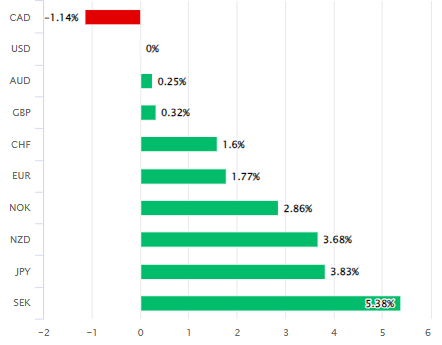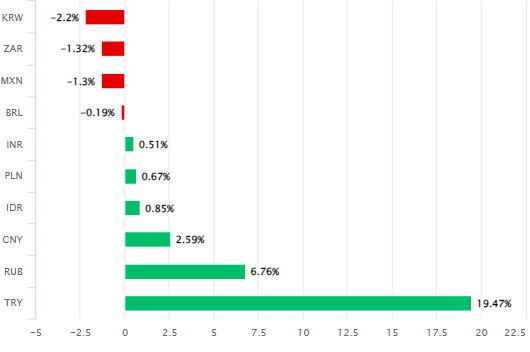The Swedish Krona's Depreciation Spiral and Recovery Prospects in Focus
- Written by: James Skinner
-
"The urge to be short GBP/SEK is strong. It’s a trade that will work in the long run" - Societe Generale.

Image © Adobe Stock
The Swedish Krona has been one of the biggest fallers on the market in the recent month and a relative underperformer for much longer but enduring trends in other major currency exchange rates suggest inflation has been a prominent driver of the losses and that a clear moderation of it could catalyse a recovery for the Krona.
Sweden's Krona fell more than six percent against a recovering U.S. Dollar in May and remained under pressure over the week to Thursday following a lengthy rout that has led Riksbank officials to warn of policy action and prompted analysts to describe the currency as increasingly cheap or undervalued.
"SEK weakness defies both the Riksbank’s desire for appreciation and the consensus for strength," says Adam Cole, chief FX strategist at RBC Capital Markets.
"However we measure it, SEK is now extremely 'cheap',” Cole writes in a Wednesday research briefing.
The Russian Rouble, South African Rand, Turkish Lira, New Zealand Dollar and Japanese Yen had all fallen more than the Krona for 2023 by Thursday but losses in relation to the Dollar, Euro, Swiss Franc, Pound Sterling, Canadian Dollar and others have perpetuated a spiral that dates back to the opening weeks of 2021.
Above: U.S. Dollar performance relative to G10 and G20 currencies in May. Source: Pound Sterling Live.
"In our opinion, the krone is undeservedly weak against the euro, but it is difficult to see anything that can clearly improve the market's appetite for SEK in the short term," writes Anders Eklof, a macro strategist at Swedbank, in a Monday research briefing.
"The USDSEK increase of 6% in May is one of the largest monthly increases seen in the 2000s. Several factors have contributed to the USDSEK movement, including surprisingly strong US data which contributed to a noticeable interest rate increase," Eklof adds.
The Riksbank's slower and more moderate interest rate response to rising inflation has been widely cited as a blighter of demand for Swedish Krona assets since early last year while more recently many have also flagged the resulting falls in Swedish house prices and perceived risks to financial stability as another driver of currency losses.
But the Krona's losses are following a pattern that is observable elsewhere in the market, one that is more advanced in other currencies and well illustrated by how the twists or turns in the inflation cycle have coincided almost perfectly with the tops and bottoms in the Euro to Dollar rate.
"The recent weakening of the krona is expected to add around 0.3-0.4pp to headline inflation over the next 6-12 months. The impact on core inflation is expected to be approximately 0.2pp," writes Olle Holmgren, chief strategist for Sweden at SEB, in a Wednesday research briefing.
Above: EUR/USD at weekly intervals with SEK/USD and SEK/EUR. Click for closer inspection.
The Euro to Dollar rate peaked in January 2021 as inflation bottomed out in Europe and troughed in September 2022 as inflation peaked, before reversing its recovery in May when a bounce in the U.S. core inflation rate interrupted a multi-month fall.
Europe's single currency has shown a clear bias for depreciation when inflation is rising and a tendency to appreciate when inflation is falling, while the same has also been true in GBP/USD, as well as between U.S. inflation and the Dollar price of gold.
Sterling has long been responsive to the evolution of inflation in the UK but as far as the Euro-Dollar rate behaviour illustrates how the wider market responds to inflation more generally, it would suggest that inflation has been driving the Swedish Krona's losses, and reveal what it might take to prompt a recovery.
"There is hope that inflation will drop in line with forecasts, not least because companies’ price plans have continued to decline. However, the weak SEK trend and its possible effects on inflation are a concern," says Torbjorn Isaksson, an analyst at Nordea Markets.
"It will probably delay the downturn, but inflation should nevertheless drop substantially during the remainder of this year," Torbjorn writes in a Thursday research briefing.
Above: Pound to Swedish Krona rate shown at monthly intervals alongside USD/SEK and EUR/SEK.
Inflation has risen further in Sweden than in other G10 economies and has remained higher for longer than elsewhere too with the consumer price index inflation rate, the most internationally comparable, having reached its peak later than in other advanced economies and plateaued just beneath its peak since then.
Swedish inflation peaked around 12.3% in December and some three months after the peak in other major economies but has since fallen only slowly to reach 10.5% in April, while the multi-year trend in exchange rates like EUR/USD and GBP/USD suggests that this might best explain the Krona's underperformance since then.
But the above trends also indicate that Sweden's currency would likely have scope to recover some of its losses as and when inflation more clearly decelerates, and this eventual recovery might lift the Krona as far as levels like 9.4548, 11.8330 and 10.0355 in USD/SEK, GBP/SEK and EUR/SEK respectively.
These are something like the levels that would prevail if all other influences were excluded so exchange rates reflected only the positive and negative effects that inflation and interest rate differentials can have on the notion of fundamental or 'fair' value.
"The urge to be short GBP/SEK is strong. It’s a trade that will work in the long run, but the Riksbank, like the Norges Bank, is reluctant to match the pace of ECB rate hikes," says Kit Juckes, chief FX strategist at Societe Generale. "I will slowly start building a holiday pot of GBP/SEK shorts for next summer – it might be a bit early, but it will work by then."










